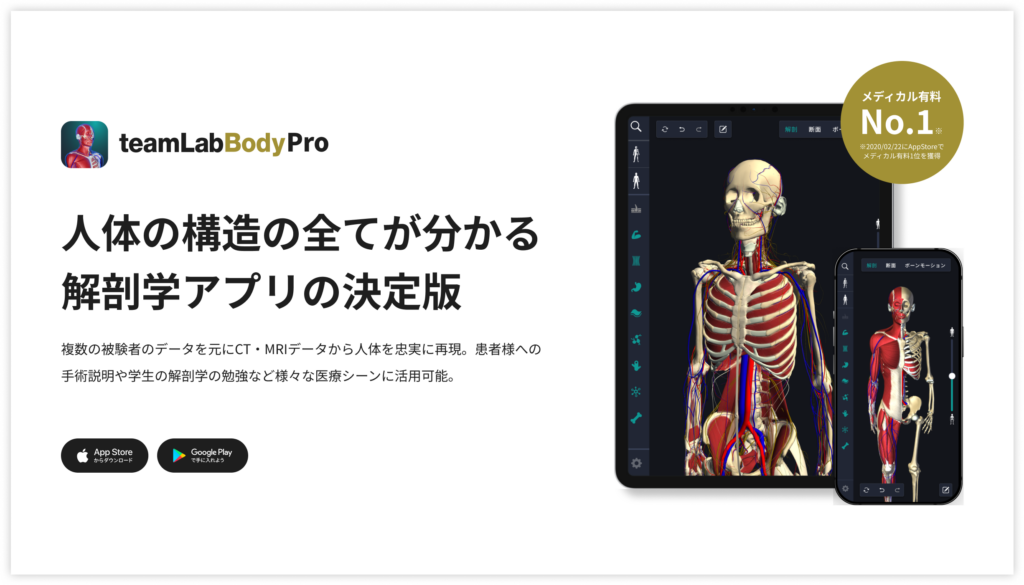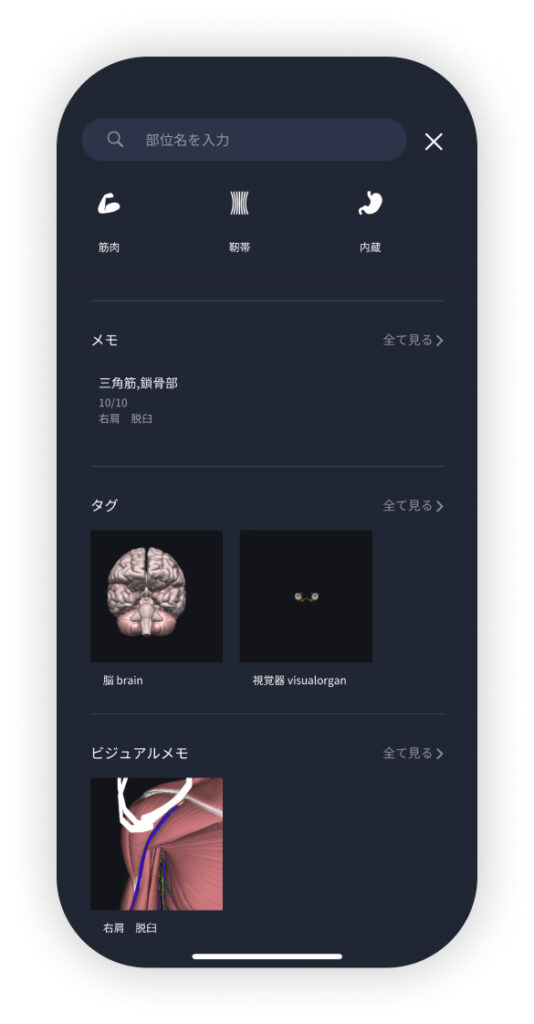beginning
In this article, I will explain effective study methods, starting with knowledge of specialized parts in human anatomy.
In human anatomy, it is necessary not only to memorize the names of various organs, muscles, and bones, but also to remember where they are located in the body. Therefore, it is necessary to learn as efficiently as possible.
I hope you will deepen your understanding even a little by reading this article and using the app.
Now, I'll explain the details about the “pterygoid ligament” and how to study human anatomy.
teamLab Body Pro Free Download
A 3D anatomy app that shows all the structures of the human body
Download teamLab Body Pro here!

What is pterygiform ligament?
The anatomy application allows you to view a selection of anatomy 3D models. In this model, there are various observation methods such as surfaces, cross-sections, and nervous systems. This time, I'll explain using an anatomy application.
About pterygoid ligament

The pterygiform ligament (alar ligament) is a strong ligament structure connecting the outer edge of the large occipital foramen in the occipital bone of the skull to the outer surface of the axial vertebra (2nd cervical vertebra: C2). They exist in pairs, left and right, and mainly have the function of limiting excessive rotational movement of the head. This maintains the stability of the atlantoaxial joint (C1-C2) and the atticular occipital joint (C1-occipital bone). The pterygiform ligament is short, strong, and is located deep in the neck and hidden behind the anterior longitudinal ligament and above the cruciate ligament.
This ligament may be damaged during “whiplash” or cervical spine trauma caused by traffic accidents, etc., and when the ligament is torn, instability during head rotation and neurological symptoms may occur. In particular, the structure of the atticular vertebrae and axial vertebrae is close to the top of the spinal cord, and there is a risk that slight instability will cause serious neurological damage, so damage assessment of the pterygoid ligament is extremely important. Scrutiny with MRI, etc., and clinically, manual tests to confirm cervical rotation restrictions are performed.
Even though it is difficult to see, this ligament, which is the cornerstone of neck stability, is an important structure that should be understood from both basic anatomical and clinical perspectives.
Study points
Anatomical understanding: understanding the location and structure of the pterygium ligament
The pterygoid ligament is a ligament that connects the dentate process of the axial spine to the occipital bone, and is one of the intrinsic ligaments that reinforce the atlantoaxial joint. Ligaments exist on the left and right, run diagonally upward and outward from the outer surface of the dental process, and adhere to the outer edge of the large occipital foramen of the occipital bone. It has a short and thick structure and is located deep in the neck along with the cruciate ligament and posterior longitudinal ligament. In order to learn these, it is effective to capture the structure three-dimensionally with a cross-sectional view or 3D anatomy application. Also, understanding is deepened by using models of skulls and cervical vertebrae to confirm the attachment position between the joint surface and ligaments while visually and palpating.
Functional understanding: Contribution to head rotation control and stability
The pterygiform ligament has the role of applying brakes so that the head does not rotate excessively from side to side. For example, the right pterygium stretches when the head rotates to the left, limiting movement. This prevents excessive misalignment between the skull and cervical spine and protects the spinal cord. When learning, actually turn your head left and right, and if you are aware of “which direction the restriction is applied” and “how the deep structure is moving at that time,” it will be easier to grasp the functional image of ligaments. By thinking in relation to movement restrictions, retention in memory will also improve.
Practical Applications: Injury Instability and Clinical Assessment
Clinically, the pterygoid ligament may be damaged by traffic injuries or sports injuries. In particular, in “whiplash” and high-energy trauma, head instability and neurological symptoms may occur due to rupture or looseness of these ligaments. In addition to evaluation by MRI, manual tests such as an “alarm test,” which rotates the neck to confirm whether ligament restrictions are functioning, are also used. In order to understand such tests, it is important to learn both “which movements apply a load” and “how the positional relationship with nerves and blood vessels” is based on the anatomy and function of ligaments.
How to study human anatomy
I will explain specific study methods using human anatomy applications.
Check your past learning history and practice repeatedly
Here are the steps to check your anatomy learning history and practice iteratively effectively.
1. Check your learning history in the app
Reviewing your learning history with the application is an important step in effectively advancing anatomy learning. First, launch the app and go to the learning history section from the main menu. Many anatomy apps are designed to show your progress in the form of graphs and lists, so you can visually check which parts you've learned about and how much time you've spent.
By using this data, you can understand which areas you have strengths in and where you need to spend more time and effort. We also recommend using a dedicated tag or notebook function to mark areas you are particularly weak at or where you need to relearn. Regularly checking your learning history and looking back on past learning content will lead to efficient review and deepening understanding.
2.Make a plan for iterative learning
Making an efficient repetitive learning plan based on learning history is extremely effective in promoting knowledge retention. First, identify weak points and areas where you need to relearn. Next, arrange these study items into a weekly or monthly calendar and create a specific study schedule. By proceeding in a planned manner, you can learn each part evenly and avoid packing in a large amount of information at once.
Using a task management app or digital calendar to set study reminders is effective. Also, it's important to have the flexibility to regularly review progress and revise plans as needed. By having goals and proceeding with your studies in a planned manner, you can efficiently acquire anatomical knowledge.
3.Use 3D features to learn visually
By utilizing the 3D function, learning anatomy is easier to understand visually. The 3D model shows the structure of the human body three-dimensionally, and each part can be observed in detail. This makes it possible to intuitively grasp positional relationships between deep muscles and organs that are difficult to capture in a planar view. For example, you can learn even the smallest details by rotating specific muscles and bones and zooming in and out.
Also, there are many apps that have the function of displaying cross-sectional views of each part using a 3D model, which is useful for deepening understanding of internal structures. This diversity of visual information helps with memory retention and improves immediate responsiveness in tests and practice situations. By utilizing the 3D function and learning visually, you can learn anatomy knowledge more deeply and efficiently.
Use the memo function concretely

Make notes so you don't forget the things and points you've noticed while studying. The memo function can be used for different purposes, such as inputting text, saving images, and writing memos. Tag your notes to make them easier to review later.
Test your learning regularly in the form of quizzes
Regularly testing what you've learned in a quiz format is a very effective way to anchor your anatomy knowledge. Quiz-style tests help you objectively grasp your level of understanding and areas you lack while repeating knowledge.
For example, by using a learning app to conduct quizzes every specific period, you can reconfirm what you've learned and strengthen your memory. There are a wide range of quiz formats, such as multiple choice questions, fill-in-the-blank questions, and short answer questions, and each helps understanding from a different angle and develops the ability to utilize various types of knowledge.
Get feedback
If possible, get feedback from other learners and experts. It helps you find your own gaps in understanding and areas for improvement. You can also keep yourself motivated to learn by regularly testing yourself. Feeling a sense of accomplishment and progress increases motivation for continuous learning.
summary
This time, I explained how to study about the “pterygoid ligament” using an application!
Thank you for reading this far.
I would be happy if reading this article helped you learn about anatomy.
Learning is a long, never-ending journey, but I sincerely wish you all the best. Let's continue to study together and work hard for the national exam!
Please look forward to the next blog.
teamLab Body Pro Free Download
A 3D anatomy app that shows all the structures of the human body
Download teamLab Body Pro here!





